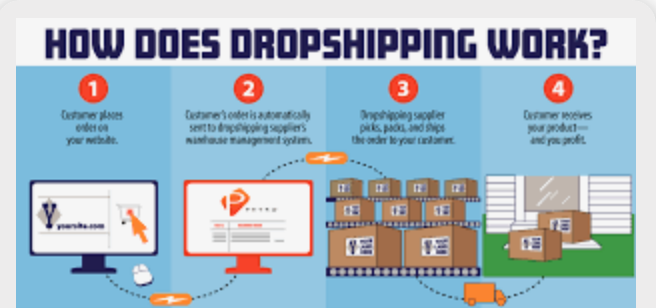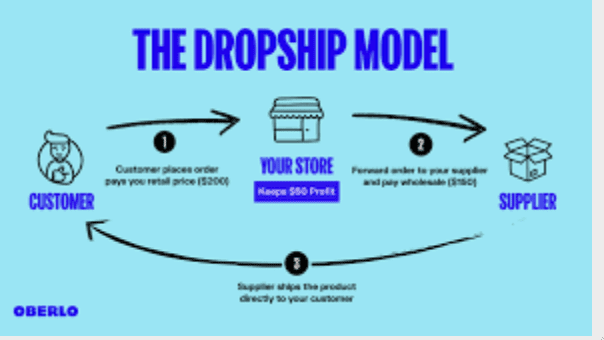Dropshipping is a popular business model that allows entrepreneurs to sell products without having to carry inventory. In this article, we will explore not only how to run a dropshipping business, but we will show you how dropshipping works.
You will learn step by step how to become a drop shipper, the potential profitability for beginners, the benefits and drawbacks of dropshipping, profitable niches to consider, setting up a dropshipping store, marketing and driving traffic to your store, scaling your business for success, alternatives to dropshipping, and final thoughts.
1. What Is Dropshipping and How Does It Work?
Dropshipping is a business model where a store owner partners with a wholesale supplier to sell products. The store owner lists the supplier’s products on their online store, and when a customer places an order, the supplier handles the fulfillment and ships the product directly to the customer. The store owner doesn’t need to handle inventory or shipping logistics.
2. How to Become a Dropshipper?
To become a drop shipper, follow these steps:
- 1. Choose a niche: Identify a specific market or product category to focus on.
- 2. Research suppliers: Find reliable suppliers who offer dropshipping services.
- 3. Set up an online store: Create an e-commerce website using platforms like Shopify, WooCommerce, or BigCommerce.
- 4. Source products: Connect with suppliers and import their products to your store.
- 5. Customize your store: Design your store, write compelling product descriptions, and optimize for conversions.
- 6. Set competitive prices: Determine your pricing strategy based on costs, market research, and desired profit margins.
- 7. Start marketing: Use various marketing channels to attract potential customers to your store.
- 8. Manage orders: When customers place orders, forward them to the supplier for fulfillment.
- 9. Focus on customer service: Provide excellent support to build trust and encourage repeat business.
3. Can You Make Money with Dropshipping as a Beginner?
Yes, it’s possible to make money with dropshipping as a beginner. However, success depends on factors like product selection, marketing strategies, pricing, customer service, and continuous learning. It’s important to be patient, test different approaches, and adapt your business based on the results.
4. The Benefits of Dropshipping
- – Low startup costs: You don’t need to invest heavily in inventory upfront.
- – Minimal risk: Since you only purchase products when you have confirmed orders, there’s no excess inventory.
- – Flexibility and location independence: You can run your business from anywhere with an internet connection.
- – Wide product selection: You can offer a diverse range of products without needing to stock them.
- – Easy to scale: As your business grows, you can add new products and expand into different markets.
5. Potential Drawbacks and Challenges of Dropshipping
- – Lower profit margins: Due to increased competition and supplier costs, profit margins can be relatively low.
- – Inventory and product quality control: Since you rely on suppliers, you have less control over the quality and availability of products.
- – Shipping complexities: Shipping times can vary, and coordinating with multiple suppliers can be challenging.
- – Customer service responsibility: As the store owner, you are responsible for handling customer inquiries and complaints.
6. Profitable Niches for Dropshipping
Some profitable niches to consider for dropshipping include:
- – Health and wellness products
- – Home decor and accessories
- Beauty and skincare
- – Tech gadgets and accessories
- – Fitness and sports equipment
- – Sustainable and eco-friendly products
- – Baby products and accessories
7. Setting Up a Dropshipping Store
To set up a dropshipping store, follow these steps:
- 1. Choose a domain name: Select a memorable and relevant domain name for your store.
- 2. Choose an e-commerce platform: Consider platforms like Shopify, WooCommerce, or BigCommerce.
- 3. Install and customize your theme: Select a visually appealing theme and customize it to align with your brand.
- 4. Import products: Connect your store to your supplier’s platform or use dropshipping apps to import products.
- 5. Optimize product pages: Write compelling product descriptions, add high-quality images, and optimize for SEO.
- 6. Set up payment and shipping methods: Configure payment gateways and shipping options for seamless transactions.
- 7. Test your store: Ensure everything is functioning correctly before launching.
- 8. Launch your store: Promote your store through various marketing channels to start attracting customers.
8. Marketing and Driving Traffic to Your Dropshipping Store
To market and drive traffic to your dropshipping store, try these strategies:
- – Search engine optimization (SEO): Optimize your product pages and blog content for search engines.
- – Social media marketing: Utilize platforms like Facebook, Instagram, and Pinterest to engage with your target audience.
- – Influencer partnerships: Collaborate with influencers in your niche to promote your products.
- – Content marketing: Create valuable content through blog posts, videos, or podcasts to attract organic traffic.
- – Email marketing: Build an email list and send regular newsletters and promotions to engage with customers.
- – Paid advertising: Consider running ads on platforms like Google Ads, Facebook Ads, or Instagram Ads.
9. Scaling Your Dropshipping Store for Success
To scale your dropshipping store and increase profitability:
- – Analyze data: Use analytics tools to understand customer behavior, identify trends, and make data-driven decisions.
- – Expand product offerings: Continuously research and add new products to attract a wider customer base.
- – Optimize conversions: Test different website elements, implement sales funnels, and optimize your checkout process.
- – Build a brand: Focus on creating a strong brand identity to differentiate yourself from competitors.
- – Explore new marketing channels: Consider exploring emerging platforms or partnerships to reach new audiences.
- – Automate and outsource: Delegate repetitive tasks and streamline your operations using tools and virtual assistants.
Watch How I Earn A Passive Income Working From Home In 7 Months Using This Simple 4-Step Formula
10. Alternatives to Dropshipping
If dropshipping doesn’t align with your goals or preferences, consider these alternatives:
- – Stocking inventory: Purchase and manage your inventory directly.
- – Print-on-demand: Create custom products that are printed and shipped on demand.
- – Wholesale: Purchase products in bulk at a discounted price and handle fulfillment yourself.
- – Manufacturing: Design and produce your own products to sell.
- – Affiliate marketing: Promote other companies’ products and earn a commission for each sale.
Final Thoughts
Running a dropshipping business can be an exciting and rewarding venture. By understanding the intricacies of the model, carefully selecting profitable niches, implementing effective marketing strategies, and continuously adapting to market trends, you can build a successful dropshipping store.
Remember, patience, perseverance, and a commitment to providing excellent customer service are key to long-term success in this industry.
Note: This article provides a comprehensive overview of running a dropshipping business based on the outline. However, it’s always recommended to conduct further research and stay updated with the latest trends and best practices in dropshipping.
If you need help choosing the right Affiliate Program, check out my #1 recommendation on building a successful Affiliate business online. You can get access to hundreds of training videos, 24/7 support, professional consultations, private access to training guides, tools, personal private assistance, my personal help, and much more.
PS: Wealthy Affiliate Review, (My #1 recommendation in detail).




